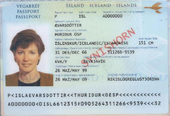| |
|---|---|
 The front cover of a first-generation Icelandic biometric passport issued from 2006–2019 | |
 The biodata page of an Icelandic biometric passport | |
| Type | Passport |
| Issued by | |
| First issued | 1 June 1999 (machine-readable passport) 23 May 2006[1] (biometric) 1 February 2019 (current version) |
| In circulation | 354.815 (94.9% of citizens)[2] |
| Purpose | Identification |
| Eligibility | Icelandic citizenship |
| Expiration | 10 years from date of issue (adults, 2018) |
| Cost | 14,000 ISK (adults aged 18–66 years; regular application) 28,000 ISK (adults aged 18–66 years; urgent application) 6,000 ISK (children below 18 years, elderly aged 67 years and above, disabled people; regular application) 12,000 ISK (children below 18 years, elderly aged 67 years and above, disabled people; urgent application)[3] |
Icelandic passports (Icelandic: íslenskt vegabréf) are issued to citizens of Iceland for the purpose of international travel. Beside serving as proof of Icelandic citizenship, they facilitate the process of securing assistance from Icelandic consular officials abroad (or public officials in the mission of another Nordic country in case an Icelandic consular official is absent).[4][5] As of 2023, 94.9% of Icelandic citizens possess an Icelandic passport.[6] It is one of three official documents issued by the Icelandic government, the others being the Icelandic identity card and the Icelandic driving licence.
The passport allows for the freedom of movement in any of the states of EFTA[7] and the EEA. This is because Iceland is a member state of EFTA, and by virtue of it also being a member of the European Economic Area (EEA) and part of the Schengen Area. For travel within the Nordic countries no identity documentation is legally required for Nordic citizens due to the Nordic Passport Union.

The first passports were issued since at least the early 1900s, however a standard book became available in the 1930s.[8] In World War Two, during the British occupation of Iceland, the Icelandic passport became mandatory identification document to be carried at all times. As no other identification documents were produced by the state, the passport was used. The local police issued domestic passports to everyone, a simple printed blue paper book, different to previous international passports. After the war, the requirement was abolished.[9] In the 1950s, a new design was put into circulation, more akin to international designs.
A new design was put into circulation in May 1987.[10] It featured a dark blue (near-black) cover, laser-printed pages, and a laminated information page.
The first machine-readable Icelandic passports were introduced on 1 June 1999,[11] having a blue cover, a machine-readable strip and improved security features. A hard-plastic page with a biometric chip was added in May 2006,[12] and the validity was temporarily shortened from ten years to five. In June 2013, the chip was relocated to the back cover and the validity restored to ten years.[12] In 2004, 81% of Icelandic citizens had a passport.[13]
A new Icelandic passport design was introduced on 1 February 2019, featuring a slightly enlarged Icelandic coat of arms and sans-serif wording on the front cover.[14] They are manufactured by the Polish Security Printing Works.[15]
Icelandic passports are blue, with the Icelandic coat of arms emblazoned in the centre of the front cover. The words "ÍSLAND" (Icelandic), "ICELAND" (English) and "ISLANDE" (French) are inscribed above the coat of arms and the words "VEGABRÉF" (Icelandic), "PASSPORT" (English) and "PASSEPORT" (French) are inscribed below the coat of arms. Icelandic passports have the standard biometric symbol at the bottom.[16]
Vegabréf, the Icelandic word for passport, literally means "road letter", which was the Scandinavian word for internal passports when such existed in Scandinavia.

The Icelandic passport includes the following data:
The information page ends with the Machine Readable Zone.
Personal names containing the special Icelandic letters (ð, þ, æ, ö) are spelled the correct way in the non-machine-readable zone, but are mapped in the machine-readable zone. ð becomes D, þ becomes TH, æ becomes AE, and ö becomes OE.
Letters with accents are replaced by simple letters (e.g., é → E). This follows the standard for machine-readable passports.
The data page/information page is printed in Icelandic, English and French.
|
Main article: Visa requirements for Icelandic citizens |

Visa requirements for Icelandic citizens are administrative entry restrictions by the authorities of other states placed on citizens of Iceland. As of 3 April 2020, Icelandic citizens had visa-free or visa-on-arrival access to 180 countries and territories, ranking the Icelandic passport 11th in the world in terms of travel freedom (tied with Latvian and Slovenian passports) according to the Henley Passport Index.[17]
As a member of the European Free Trade Association (EFTA), Icelandic citizens have freedom of movement to live and work in other EFTA countries in accordance with the EFTA convention.[7] Moreover, by virtue of Iceland's membership of the European Economic Area (EEA), Icelandic citizens also enjoy freedom of movement within all EEA member states. The Citizens’ Rights Directive[18] defines the right of free movement for citizens of the EEA,[19] and all EFTA and EU citizens are not only visa-exempt but are legally entitled to enter and reside in each other's countries.
Inside Iceland and the other Nordic countries, an Icelandic identity card or Icelandic driving licence is sufficient for personal identification. Driving licences do not state citizenship and therefore are not usable in most cases as travel documentation.
The Icelandic identity cards, called Nafnskírteini, were updated in 2024 adhering to biometric ICAO and EU standards, allowing its use as a travel document throughout the EU/EEA.